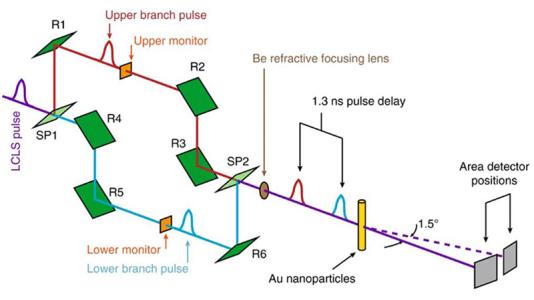
Scientific Achievement
Using split X-ray pulses at the LCLS, nanoscale nanosecond equilibrium structural dynamics were measured in a colloidal liquid, marking the first demonstration of split-and-delay ultrafast hard X-ray photon correlation spectroscopy.
Significance and Impact
This work enables the study of atomic-length-scale dynamics of materials over time scales of femtoseconds to nanoseconds at X-ray laser light sources, filling a critical gap in measuring equilibrium dynamics in complex systems.
Research Details
- A split-and-delay instrument was used to temporally separate individual LCLS pulses by 1.3 nanoseconds, and two-pulse speckle patterns were measured from a suspension of gold nanoparticles in hexane at different scattering vectors.
- Contrast was extracted from very weak speckle patterns using maximum likelihood fitting, enabling dynamics to be observed.
Work was performed at Argonne and SLAC National Laboratories.
Argonne National Laboratory seeks solutions to pressing national problems in science and technology. The nation’s first national laboratory, Argonne conducts leading-edge basic and applied scientific research in virtually every scientific discipline. Argonne researchers work closely with researchers from hundreds of companies, universities, and federal, state and municipal agencies to help them solve their specific problems, advance America’s scientific leadership and prepare the nation for a better future. With employees from more than 60 nations, Argonne is managed by UChicago Argonne, LLC for the U.S. Department of Energy’s Office of Science.
The U.S. Department of Energy’s Office of Science is the single largest supporter of basic research in the physical sciences in the United States and is working to address some of the most pressing challenges of our time. For more information, visit https://energy.gov/science.